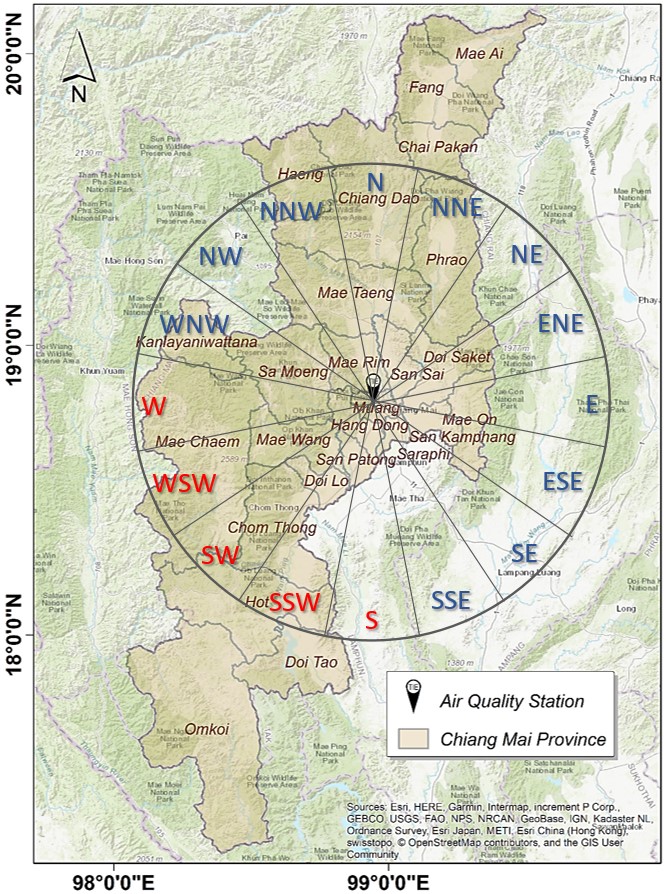ปัจจัยทางอุตุนิยมวิทยาที่สัมพันธ์ต่อการเกิดปัญหามลพิษทางอากาศในจังหวัดเชียงใหม่
Main Article Content
Abstract
Chakrit Chotamonsak and Duangnapha Lapyai
รับบทความ: 20 เมษายน 2561; แก้ไขบทความ: 8 สิงหาคม 2561; ยอมรับตีพิมพ์: 31 ตุลาคม 2561
บทคัดย่อ
การศึกษานี้มีวัตถุประสงค์เพื่อศึกษาปัจจัยทางอุตุนิยมวิทยาที่สัมพันธ์ต่อปัญหามลพิษทางอากาศในจังหวัดเชียงใหม่ โดยวิเคราะห์ความสัมพันธ์ระหว่างปัจจัยทางอุตุนิยมวิทยาซึ่งประกอบด้วย ปริมาณน้ำฝน อุณหภูมิสูงสุด อุณหภูมิต่ำสุด ทิศทางและ ความเร็วลม ความกดอากาศและความชื้นสัมพัทธ์ กับความเข้มข้นของฝุ่นละอองขนาดเล็กเส้นผ่าศูนย์กลางไม่เกิน 10 ไมครอน (PM10) ช่วงปี ค.ศ. 1998–2012 โดยวิธีทางสถิติที่ใช้ในการวิเคราะห์คือการวิเคราะห์ค่าสหสัมพันธ์และการวิเคราะห์องค์ประกอบหลัก ผลการศึกษาพบว่าในช่วงที่เกิดปัญหามลพิษทางอากาศอุณหภูมิสูงสุดรายวันมีความสัมพันธ์เชิงบวกในขณะที่อุณหภูมิต่ำสุดรายวันมีความสัมพันธ์เชิงลบกับค่าความเข้มข้นของฝุ่น PM10 ส่วนค่าความชื้นสัมพัทธ์ ปริมาณน้ำฝน และจำนวนวันฝนตกในช่วงฤดูปัญหาหมอกควันพบว่ามีความสัมพันธ์กับช่วงที่ค่าความเข้มข้นของฝุ่น PM10 มีค่าต่ำ การวิเคราะห์ความสัมพันธ์ระหว่างความเร็วลมและทิศทางลมพบว่าช่วงที่ค่าความเข้มข้นของฝุ่น PM10 เกินค่ามาตรฐานมีความสัมพันธ์กับช่วงวันที่ความเร็วลมมีค่าต่ำ โดยความเร็วลมต่ำส่งผลต่อศักยภาพในการแพร่กระจายของมลพิษทางอากาศ ประกอบกับลักษณะภูมิประเทศของจังหวัดเชียงใหม่ที่มีมีลักษณะเป็นแอ่งกระทะทำให้ความเร็วลมต่ำเอื้อต่อการสะสมของมลพิษภายในแอ่ง ในขณะที่ทิศทางลมพบว่าช่วงวันที่ค่าฝุ่น PM10 เกินมาตรฐาน ลมที่พัดส่วนใหญ่มาจากทิศใต้–ทิศตะวันตกของตัวเมืองเชียงใหม่ซึ่งพื้นที่ดังกล่าวเป็นพื้นที่สูงและเป็นพื้นที่ที่มีการเผาชีวมวลจำนวนมาก ประกอบกับลักษณะภูมิประเทศของจังหวัดเชียงใหม่ ลมจึงสามารถพัดพาเอามลพิษจากบริเวณที่มีแหล่งกำเนิดมลพิษมากดังกล่าวเข้าสะสมในแอ่งเชียงใหม่ นอกจากนี้ผลการศึกษายังพบว่าช่วงที่ความเข้มข้นของ PM10 มีค่าสูงมักเป็นช่วงที่มีความความกดอากาศสูงแผ่มาปกคลุมจังหวัดเชียงใหม่
คำสำคัญ: ความสัมพันธ์ ปัจจัยทางอุตุนิยมวิทยา มลพิษทางอากาศ เชียงใหม่
Abstract
This study aimed to study the meteorological factors related to air pollution in Chiang Mai province. The meteorological factors including rainfall, maximum and minimum temperature, wind speed and direction, sea level pressure and relative humidity were analyzed with the concentration of particulate matter less than 10 microns in diameter (PM10) during haze season (January–April) of the year 1998–2012. The statistical methods used in this study were linear regression and principal component analysis. The results showed that during the peak air pollution, the daily maximum temperature was positively correlated while the daily minimum temperature was negatively correlated with the PM10 concentration. Relative humidity, rainfall, and the number of rainy days were found to be negatively correlated with PM10 concentrations. The events that the concentration of PM10 beyond the national standard level were associated with the weak wind speed events. The topography of Chiang Mai was the basin characterized, which made the weak wind suitable for reduction dispersion potential and accumulation of pollutants within the basin. The wind direction that related to the above PM10 standard mostly blew from the south–west of Chiang Mai, where has been the highland and the large biomass burned area. Together with Chiang Mai topography, the wind could blow the pollutants from the burned area and accumulate in the basin. In addition, the results showed that high PM10 concentration events usually dominate when the high pressure had covered Chiang Mai province.
Keywords: Relationship, Meteorological factors, Air pollution, Chiang Mai
Downloads
Article Details

This work is licensed under a Creative Commons Attribution-NonCommercial 4.0 International License.
References
Aguado, E., and Burt, J. E. (2013). Understanding Weather & Climate. 6th ed. New York: Pearson.
Chotamonsak, C., and Lapyai, D. (2014). Final Report “Changes in Temperature and Precipitation Extremes in Northern Thailand”. Chiang Mai: Faculty of Social Science, Chiang Mai University. (in Thai)
Dawson, J. P., Racherla, P. N., Lynn, B. H., Adams, P. J., and Pandis, S. N. (2009). Impacts of climate change on regional and urban air quality in the eastern United States: Role of meteorology. Journal of Geophysical Research–Atmospheres 114: 11.
Dontree, S., Saravisutra, A., Pichipajja, P., Pinkantayong, P., and Noysuya, S. (2014). Final Report: Spatial Clustering of Burned Areas for Open Field Burning Surveillance and Prevention: Case Studies of Chiang Mai, Lamphun and Mae Hong Son Provinces. Thai Universities for Healthy Public Policies, Thai Health Promotion Foundation. (in Thai)
Jacob, D. J., and Winner, D. A. (2009). Effect of climate change on air quality. Atmospheric Environment 43(1): 51–63.
Kreasuwan, J., Chotamonsak, C., Wiranwet-chayan, O., and Ratjiranukool, P. (2008). Final report: Simulation of Particulate matter in Chiang Mai – Lamphun basin. Bangkok: National Research Council of Thailand. (in Thai)
Kreasuwan, J., Chotamonsak, C., Wiranwet-chayan, O., and Ratjiranukool, P. (2009). Final report: Pirot project for developing of air quality early warning system in Chiang Mai – Lamphun basin: Sub-project2-Weather Analysis and Air Pollution Warning. Bangkok: The Thailand Research Fund. (in Thai)
Pasch, A. N., MacDonald, C. P., Gilliam, R. C., Knoderer, C. A., and Roberts, P. T. (2011). Meteorological characteristics associated with PM2.5 air pollution in Cleveland, Ohio, during the 2009-2010 Cleveland Multiple Air Pollutants Study. Atmospheric Environment 45(39): 7026–7035.
Piansangsan, L. (2014). Principle Component Analysis. Retrieved from https://www.gotoknow.org/posts/566063, January 15, 2018. (in Thai)
Pope, C. A., Burnett, R. T., and Thun, M. J. (2002). Lung cancer, cardiopulmonary mortality, and long–term exposure to fine particulate air pollution. Jama–Journal of the American Medical Association 287(9): 1132–1141.
Rayanakorn, M., Chantara, S., Wangkarn, S., Tengcharoenkul, U., Kitsawatpaibul, P., Chanta, P., Chaisri, I., Sangbun, D., and Sangchan, W. (2007). Final report: Analysis for Air Pollutants in Airborne Particulates in Chiang Mai and Lamphun Provinces. Bangkok: The Thailand Research Fund. (in Thai)
Schoennagel, T., Veblen, T. T., and Romme, W. H. (2004). The Interaction of fire, fuels, and climate across Rocky Mountain forests. BioScience 54(7): 661-676.
Silcox, G. D., Kelly, K. E., Crosman, E. T., Whiteman, C. D., and Allen, B. L. (2012). Wintertime PM (2.5) concentrations during persistent, multi–day cold–air pools in a mountain valley. Atmospheric Environment 46: 17–24.
Vinitketkumnuen, U., Chewonarin, T., Taney-hill, K., and Chunrum, N. (2007). Final Report: Oxidative Damage to DNA from Alveolar Lung Cell Lines by Air–borne particulate Matter PM 2.5 & PM 10 extractable from Chiang Mai and Lumphun. Bangkok: The Thailand Research Fund. (in Thai)
Whiteman, C. D. (2000). Mountain Meteorology: Fundamental and Applications. New York: Oxford University.
Whiteman, C. D., Pospichal, B., Eisenbach, S., Weihs, P., Clements, C. B., Steinacker, R., Mursch-Radlgruber, E., and Dorninger, M. (2004). Inversion breakup in small Rocky Mountain and alpine basins. Journal of Applied Meteorology 43(8): 1069–1082.
